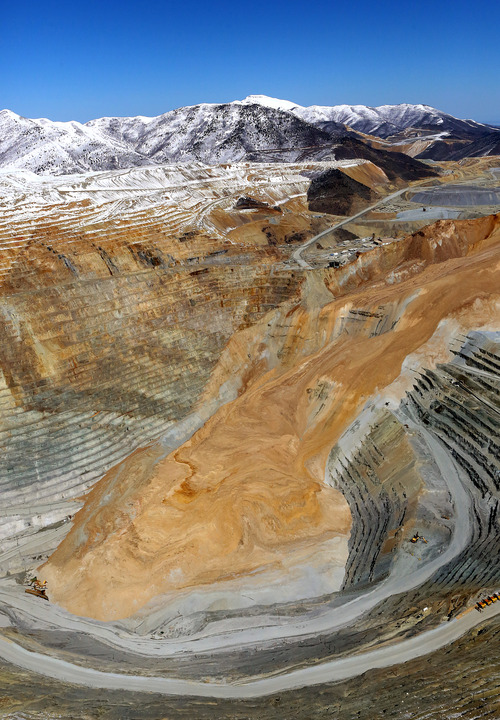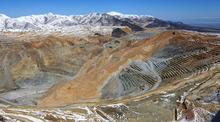This is an archived article that was published on sltrib.com in 2013, and information in the article may be outdated. It is provided only for personal research purposes and may not be reprinted.
On Thursday, fear became fact for workers at Kennecott Utah Copper. The massive April 10 landslide in Bingham Canyon Mine will cost some their jobs.
Kennecott informed union officials Thursday afternoon that an unspecified number of the company's 2,100 employees will be laid off later this month because the landslide is projected to cut mine production by 50 percent.
"At this time, we do not have numbers or a time frame in May when [the layoff] will take place," the company said in a news release. "It is always difficult when jobs are lost because of the direct impact it has on individuals and families. Our work force is an important consideration in every decision that we make."
Wayne Holland, international staff representative for the United Steelworkers of America, which represents about 1,500 Kennecott workers, said two company officials called him about 3:15 p.m.
"They said they wouldn't know for a few more days the exact numbers, but they would probably be significant," said Holland, part of the union bargaining team for the five Oquirrh Mountain operations involved in producing copper, gold and molybdenum from the open-pit mine.
As word of pending layoffs spread, union members talked about how to manage cuts at each of those five operations — the mine, concentrator, smelter, refinery and power plant.
Scott Mullins, president of United Steelworkers Local No. 392, said his telephone line was busy throughout the afternoon with "union members calling me up, wanting to know what's going on. Unfortunately, there's not a lot of information being put out there right now — just layoffs possible by the end of the month."
Added Holland: "Our job is to try to minimize the human effects."
Kennecott spokesman Kyle Bennett said that has been the company's emphasis as well since a large chunk of the pit's northeast wall slid clear to the bottom of the mine, filling it with waste rock 300 feet deep.
No one was laid off over the last three weeks, he noted, as mine officials and the federal Mine Safety and Health Administration assessed the damage and tried to figure out what had to be done to return the mine safely to production.
The company had taken a few stopgap measures, first asking mine employees to take accrued vacation or unpaid leave, then asking the same of all company employees. It appears only a few complied with that request. Then last week, at least one contractor laid off about 40 workers.
In a media tour days later, Kennecott Utah Copper President Kelly Sanders declined several times to address questions about how employment would be impacted by a 50 percent drop in production.
As late as Tuesday, former mine general manager Ted Himebaugh told the Salt Lake County Council that the company's "first move is not to panic but to have a definite plan moving forward." But then he added, "a lot of sacrifice and uncomfortable decisions may have to be made."
Himebaugh reiterated that point later. "There will be some uncomfortable decisions that come up in the short-term that affect us and the community as well."
By Thursday, company spokesman Bennett said, it had become "obvious as we look ahead in how to adapt — when we're looking at a 50 percent production reduction — that this is a step that has to be taken. … It's a very difficult decision."
In the first week after the April 10 slide, Kennecott told customers that shipments of refined copper would continue as planned through April, but May deliveries would be down and "thereafter, we do not anticipate the ability to make further shipments for the foreseeable future."
Because of that uncertain future, the company said Thursday, "additional changes to reduce our operating costs may be required as operating plans are finalized in the coming months." Last week, Sanders said he expects to have a plan in place by late August for returning the mine to full production.
How quickly that can be done remains to be seen.
Limited mining operations restarted over the weekend, delivering 50,000 tons of copper ore to Kennecott's crusher on Saturday and another 79,000 tons on Sunday.
But the cleanup effort alone poses a major challenge.
The 150 million tons of waste rock that slid amounts to almost two-thirds of the material that Kennecott usually moves in a year.
"It doesn't sound insurmountable," Himebaugh told the council. "But compared to other slides, it is significant in its bigness."
Salt Lake County Mayor Ben McAdams, who learned of the company's plan Thursday afternoon, said through spokeswoman Alyson Heyrend that he is disappointed because of the impact of layoffs on workers' families.
"He'll continue to do as much as possible to assist the company in getting back to full strength," she added.
Slide timeline
• April 10 — A much larger section than anticipated of the Bingham Canyon Mine's northeast headwall slides, piling up waste rock 300 feet deep in the bottom of the pit.
• April 15 — Company asks its 800 Bingham Canyon mine employees to voluntarily take accrued vacation or unpaid time off.
• April 23 — The vacation/unpaid time off request is extended to all 2,100 Kennecott employees.
• April 24 — Word spreads of Kennecott contractors laying off employees.
• April 30 — Former mine general manager Ted Himebaugh tells Salt Lake County officials that jobs have been preserved so far, but "uncomfortable decisions" may be ahead.
• May 2 — Company informs union leaders of unspecified numbers of layoffs during the month.





